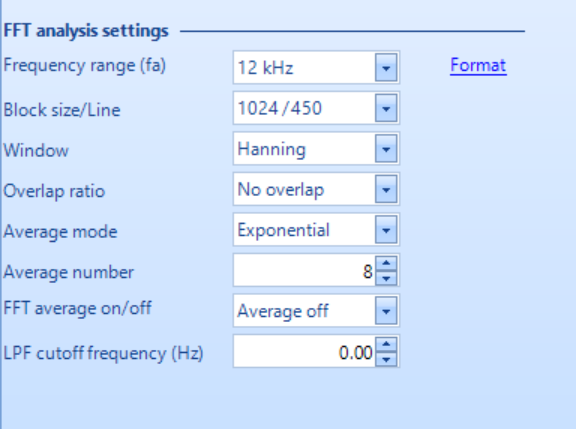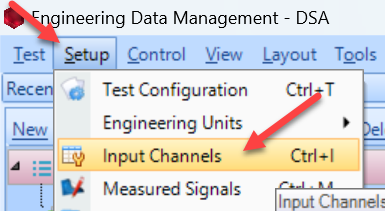DSA FFT Analysis
Follow the guided steps below on how to set-up a FFT Analysis in EDM to use with Spider hardware.
Create Test
In EDM, select to create a new test. From the New Test Wizard, select the FFT Analysis test type.
Next, give the test a name and description.
Finally, select the signal types that are wanted. You can select more than one signal type. Additionally, there Time History Stats can be selected to be calculated as well. You are unable to add more signal types to be computed once the test is created. Press Finish to create the test.
Test Configuration
Before testing, the Analysis Parameters must be configured to ensure all the data is properly measured.
Frequency Range (Sampling Rate)- determines the resolution and the span of all time and frequency data blocks. Increasing the sample rate increases time resolution (makes dT smaller) and decreases the time span (Block T) captured. Increasing the sample rate also increases the maximum frequency (Fa) in a spectral block and decreases its resolution (increases dF).
Block size/Line- are the number of samples in each time blocks and the number of (un-aliased) spectral lines in each resulting spectrum. Increasing the block size increases the resolution of the frequency transform and allows lower frequencies to be detected, but it also increases the calculation time and slows down response. The ratio between Lines and Block Size is determined by the characteristics of the A/D converter and its anti-aliasing filter. In general, this ratio is about 0.46, meaning that 1024 samples in the waveform will produce about 0.46 * 1024 = 471 lines in the spectrum.
Window- lets the user choose the window to be applied during FFT operation. Windowing functions can help reduce leakage and increase the precision of the frequency measurement. In general, select Uniform for triggered transients, Hanning for general continuous signals and Flat Top when studying tonal data (such as a rotating machine) and needing extreme accuracy of spectral peaks.
Overlap ratio- sets the proportion of the samples in a time block that are overlapped (redundant with samples in a prior block) when calculating the FFT of (un-triggered) continuous signals. Higher overlap ratios result in faster variance reduction per unit time producing smoother data, but they increase the processing requirements. The Overlap Ratio options are no overlap, 25%, 50%, 75%, 87.5%, 95% and As High As Possible. For most applications employing a symmetrically tapered window function (such as Hanning), an overlap of 50% proves optimal.
Average mode- options include Linear, Exponential, and Peak Hold. Linear averaging treats every block equally. The blocks are simply added together (at each frequency), and the result divided by the Average Number. Exponential averaging is a moving or evolving average that favors the most recently measured block. Old data slowly loses its importance (time exponentially), so that the average is dominated by the current instantaneous spectrum.
Average number- Determines the number of blocks measured for Linear and Peak Hold averages.
LPF cutoff frequency- allows the user to specify the cutoff frequency of the low-pass filter.

At the bottom of the window, the Test Summary can be found. This displays important stats about the analysis such as the Block Time, Sampling Rate, and Frequency Resolution (dF).

Input Channels
The input channels will now need to be set up. All sensors will to be properly configured before testing. The Input Channels menu can be found through Setup → Input Channels.

Measurement Quantity
Defines the physical unit that will be measured by the sensor connected to the channel.
Sensitivity
Sets the proportionality factor for the measurement (millivolts per engineering unit) given as a parameter of the sensor.
Input Mode
There are six modes in which the inputs can operate:
DC-Differential- In the DC-Differential mode, neither of the input connections is referenced to the local ground. The input is taken as the potential difference between the two input terminals, and any potential in common with both terminals is canceled out. The Common Mode Voltage (CMV) will be rejected as long as the overall input voltage level does not saturate the input gain stage. Beware that very high CMV will cause clipping and may damage the input circuitry. Signals with a nonzero mean (DC component) can be measured in this mode.
DC-Single End- In single-ended mode, one of the input terminals is grounded and the input is taken as the potential difference of the center terminal with respect to this ground. Use this mode when the input needs to be grounded to reduce EMI noise or static buildup. Do not use this mode when the signal source is ground referenced or ground loop interference may result. This mode also allows signals with a non-zero mean to be measured.
AC-Differential- AC-Differential is a differential input mode that applies a low-frequency high-pass (DC-blocking) analog filter to the input. It rejects common mode signals and DC components in the input signal. Use this when DC and low-frequency AC voltage measurements are not required or when a DC bias voltage is present. The analog high-pass filter has a cutoff frequency of -3dB at 0.3 Hz, and -0.1dB at 0.7 Hz for the IEPE input mode.
AC-Single End- AC-Single End grounds one of the input terminals and enables the DC-blocking analog filter. Use this mode for non-ground referenced sources where measuring the DC or low-frequency components are not required. It shares the same high-pass filter as that of AC-Differential.
IEPE (ICP)- All Crystal Instruments products support IEPE (Integral Electronic PiezoElectric) constant current output type input channels. IEPE refers to a class of transducers that are packaged with built-in voltage amplifiers powered by a constant current. These circuits are powered by a 4 mA constant current source at roughly 21 Volts.
Charge- Some sensors provide a high-impedance charge output. Usually, these are high-sensitivity piezoelectric units that lack a built-in voltage mode amplifier (i.e. IEPE), allowing them to be used in high-temperature environments. The Spider-81 front-end module has a built-in charge amplifier that allows the system to read the output of these sensors.
High-Pass Filter
Ability to set a digital high-pass filter for specific channels.
Integration/Differentiation Channels can be set up to be integrated or differentiated. For example, the velocity data can be integrated from an accelerometer. NOTE: if this is selected, the original quantity of data will not be recorded (Ex. If an accelerometer is integrated, there will only be velocity data, no acceleration data.)


